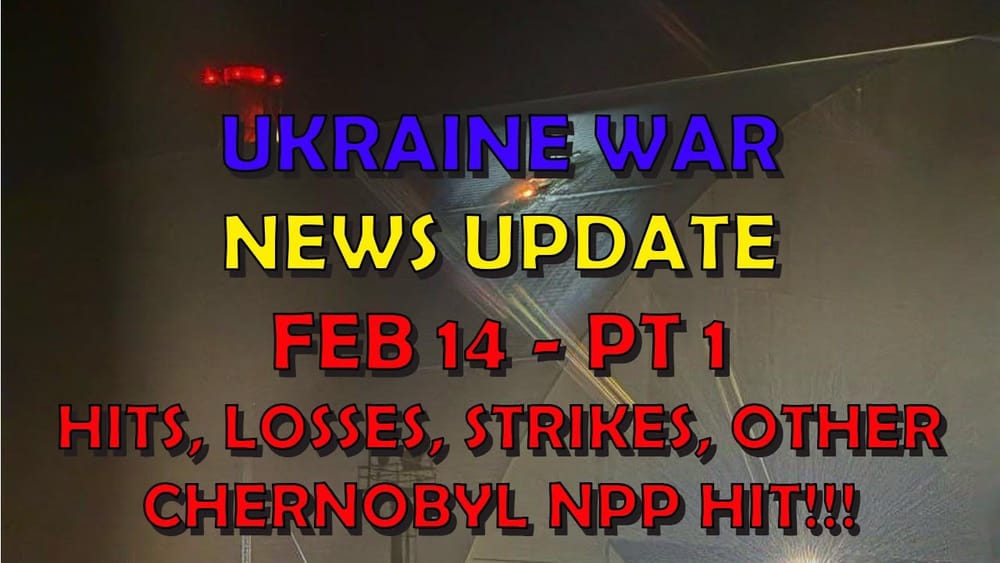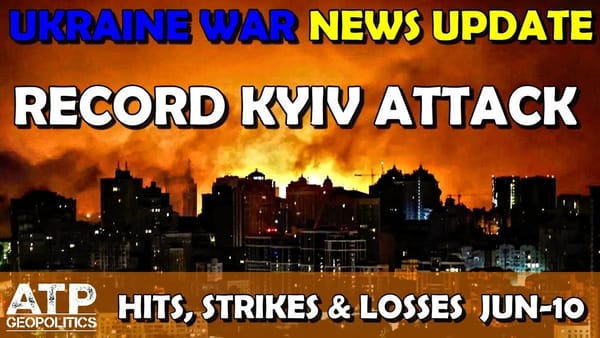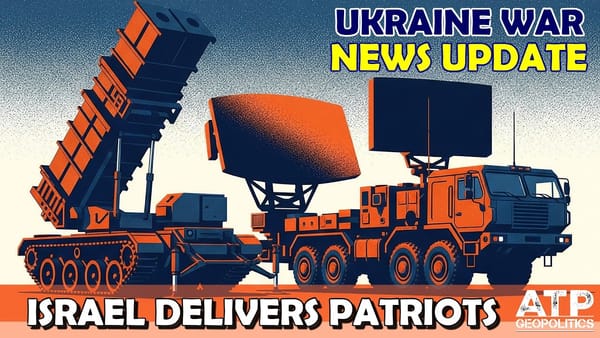Ukraine War Update NEWS: Pt 1 - Overnight & Other News, Russia Strikes Chernobyl!
Table of Contents 📖
"Russian strike on the protective sarcophagus at the Chernobyl nuclear power plant is not accidental. It is symbolic. The installation of Chernobyl new safe confinement was a unique event in the history of nuclear power safety in the world."
Hello Team
🎦 00:00-00:12⏩
Jonathan welcomes viewers to another ATP Geopolitics update. He notes that this is the first part of the update for the 14th of February 2025 and that there is little information regarding the situation on the frontlines in terms of hits and losses.
Return to top⤴️
🪦 DISCLAIMER FOR GENERAL STAFF LOSSES DATA
- These are real people with real lives and real families who love them. Don’t let the numbers sap your humanity.
- These numbers probably aren’t accurate but they’re the best we have and we don’t need them to be accurate to be indicative of patterns of activity.
- All losses are estimates. Losses cannot be counted with accuracy because of the conditions on the ground.
- Both sides would see it to be of their advantage to minimize their own losses maximize the other side’s losses.
- Neither side releases their losses but we have enough transparency from the Ukrainian side to have confidence in they are indicative.
- Personnel losses are hard to count. If a soldier gets injured, heals up, and returns to the front line only to get injured again, is that one loss or two? Also, how to deal with losses from PMC’s or soldiers fighting with RF from occupied territories?
- Equipment losses are hard to count. If an AA complex involves several parts and one part gets disabled, is that a loss, or a fraction of a loss? If a tank gets disabled, repaired, back into the fight, then disabled again, is that one lost tank or two?
- All recorded losses are vulnerable to multiple reporting. We have already seen numerous cases of multiple drones in the air reporting the same loss from different angles as multiple engagements.
- Losses are not always reported on the same day they occurred. It is frequent that drone losses are reported at least 24 hours after other terrestrial equipment losses. Certain losses may not be reported for days or weeks for military intelligence reasons.
Ukraine General Staff Figures
🎦 00:12-05:02⏩
Jonathan reviews the statistics provided by the Ukrainian General Staff, emphasizing the importance of treating these figures with caution as their accuracy cannot be independently verified. He observes the following:
- Personnel Losses: Russia has suffered approximately 1,200 personnel losses, consistent with recent trends but notably high overall.
- Tank Losses: Russian tank losses are high, at 17, prompting curiosity about the types of tanks lost and their locations.
- Troop Carrying FV Losses: Losses in this category (16) are lower than usual, raising questions about whether converted tanks (track guard and sheds) might be categorized differently.
- Artillery System Losses: A record-breaking 81 Russian artillery systems were lost, potentially signifying a significant development with tangible effects on the front lines. The actual impact depends on factors like the extent of damage and repair capabilities.
- Multiple Launch Rocket System (MLRS) Losses: Russia lost four MLRS in a single day, a substantial number.
- Anti-Aircraft Warfare System Losses: Three Russian anti-aircraft systems were lost, possibly indicating increased Ukrainian air activity.
- Vehicle & Fuel Tank Losses: Losses are significantly high at 156, suggesting potential disruptions to Russian logistics.
Jonathan speculates that increased Ukrainian artillery production, particularly of Bohdanas, might be contributing to the high Russian equipment losses.
Return to top⤴️
Prokrosk Direction Update
🎦 05:03-06:32⏩
Jonathan analyzes recent loss figures from the Prokrosk direction, noting that in January 2025, Ukrainian losses were unusually high, possibly indicating attempts to push back against Russian advances. While the overall ratio of Russian to Ukrainian losses remains unfavorable for Ukraine, February has seen some improvement, possibly suggesting Ukrainian offensive actions in areas like Kotlyna, Pistchani, and Dachenska. Despite these developments, the overall ratio remains a concern for Ukraine's long-term sustainability in this area.
Return to top⤴️
Ukrainian Military Equipment and Operations
🎦 06:33-08:39⏩
Jonathan discusses footage of a Ukrainian Mi-24B helicopter that has reportedly destroyed 19 Shahed drones and 6 reconnaissance drones. This highlights the growing role of helicopters in Ukraine's air defense strategy, particularly with the expected arrival of six upgraded German Sea King helicopters equipped for anti-air operations.
Return to top⤴️
Moldova Detains Pro-Russian Fighters
🎦 07:43-08:39⏩
Jonathan reports that Moldovan law enforcement, in collaboration with Ukrainian authorities, have detained Moldovan citizens who fought alongside Russian forces in Ukraine as part of "Operation Avengers". This operation underscores Moldova's commitment to countering pro-Russian elements within its borders.
Return to top⤴️
Russian Drone Strikes & Chernobyl
🎦 08:45-12:40⏩
Jonathan details another major Russian drone incursion into Ukrainian airspace, with 133 drones deployed. Ukrainian forces, however, demonstrated a commendable interception rate, shooting down 73 and suppressing 58 through electronic warfare. Significantly, the attack included a strike on the Chernobyl nuclear power plant, specifically targeting a shelter structure. Jonathan expresses concern about Russia's blatant disregard for nuclear safety, emphasizing the potential danger this poses to humanity. Footage of the strike is shown, capturing the drone impact. International outrage follows the attack, with Ukrainian officials, including Andriy Yermak, condemning Russia's actions. Yermak pledges to provide the US with comprehensive information about the strikes and the ensuing nuclear security threats. Analysis of drone wreckage confirms the use of Shahed Kamikaze drones. Jonathan criticizes Russia for potentially attempting to deflect blame onto Ukraine, predicting that they might accuse Ukraine of staging a false flag operation.
Return to top⤴️
Ukrainian Drone Strike on Russian Oil Refinery
🎦 10:49-11:24⏩
Shifting focus to Ukrainian drone activity, Jonathan reports on a successful strike in Krasnodar Krai, Russia. The target was the Slovyansk Eco Oil Refinery, a facility responsible for processing 9% of Russia's oil. While local authorities confirmed the attack, they provided no details on the extent of the damage. This incident marks the third attack on the refinery since 2024.
Return to top⤴️
Analysis of the Chernobyl Drone Strike
🎦 11:25-12:40⏩
Returning to the Chernobyl drone strike, Jonathan highlights analysis by Anton Gerashchenko, an advisor to the Minister of Internal Affairs of Ukraine, who argues that the strike on the Chernobyl sarcophagus was a deliberate symbolic act by Russia. Gerashchenko underscores that the Chernobyl New Safe Confinement, a unique achievement in nuclear safety history, was built through the collaborative efforts of Ukraine and its European partners, including the European Bank for Reconstruction and Development and a consortium of French companies. Completed during Trump's first term, the sarcophagus represents a testament to international cooperation and the commitment to safeguarding nuclear safety. Jonathan provides technical details about the sarcophagus, emphasizing its impressive scale at 165 meters long, 260 meters wide, and 110 meters high. He also notes the substantial cost of $2.15 billion for the shelter project. Further updates from journalist Tim White reveal that the main casing of the radioactive reactor remains intact, offering a reassuring note amidst the concerns. However, the fact that the drone flew too low for radar detection raises questions about the effectiveness of air defense systems in the region.
Return to top⤴️
Overnight Developments and Political News
🎦 12:40-13:15⏩
Jonathan acknowledges a lack of substantial information on Ukrainian overnight operations apart from the drone strike in Krasnodar Krai, indicating a shift in focus towards political developments.
Return to top⤴️
Russia to Establish Naval Base in Sudan
🎦 13:15-14:08⏩
Jonathan reports a significant geopolitical development: Sudan has granted Russia permission to establish its first naval base in Africa. Located on the Red Sea, this base will provide Russia with strategic access to this crucial waterway. The decision marks a blow to those who believed Russia's expulsion from Syria and the loss of its Tartus naval facility would limit its influence in the region.
Return to top⤴️
Peace Negotiations and the Munich Security Conference
🎦 14:08-25:11⏩
Jonathan delves into the latest developments surrounding peace negotiations and the Munich Security Conference.
- Trump's Involvement: Trump announced at a press conference that a meeting between American, Ukrainian, and Russian officials will take place in Munich to discuss a resolution to the war. This announcement has been met with skepticism and criticism, with many questioning the inclusion of Russia and Trump's diplomatic capabilities.
- US Administration's Contradictory Stances: Jonathan highlights inconsistencies within the Trump administration regarding its stance on Ukraine. While Secretary of Defense Pete Hegseth, representing the U.S. government at Ramstein, categorically stated that Ukraine would not join NATO and that sending US troops was not an option, other senior U.S. officials, including John Cole, a former Deputy Ukraine Envoy, contradicted this stance by suggesting that these options remain on the table. This discrepancy highlights chaos and a lack of clear direction within the administration.
- Trump's Controversial Statements: Jonathan criticizes Trump for suggesting that Russia should be reinstated into the G7, arguing that Russia's expulsion was justified. He challenges the narrative that Obama was weak on Russia, pointing out that it was under Obama's administration that Russia was expelled from the G8 in response to its annexation of Crimea.
- US Mineral Interests in Ukraine: A point of contention arises from a reported agreement concerning Ukraine's mineral rights. The US seemingly expects access to these resources, particularly rare earth metals, as part of a deal to aid in Ukraine's reconstruction. This has sparked debate about whether the US is prioritizing its own interests over genuine support for Ukraine.
- EU as a Potential Alternative: In response to the perceived US self-interest, Ukraine has proposed a joint venture with the EU to extract uranium, lithium, and titanium. This signals a potential shift in Ukraine's strategic alliances, opting for closer ties with Europe over dependence on the US. The European Business Association has encouraged Ukraine to declassify its mineral deposit data to facilitate international agreements and attract investments.
Jonathan suggests that closer cooperation with Europe on rare earth metals and trade could pave the way for Ukraine's eventual accession to the EU, a move that would diminish US influence.
Return to top⤴️
Wrap up
🎦 25:12-25:40⏩
Jonathan concludes by emphasizing the significance of the ongoing Munich Security Conference, anticipating further updates on the peace negotiations. He acknowledges the current dominance of political discussions over battlefield updates, attributing it to the ongoing peace talks. He signs off, promising to return soon with further analysis.
Return to top⤴️



